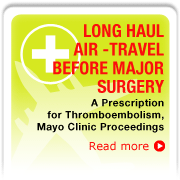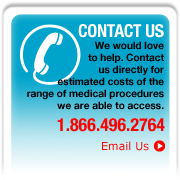New study numbers US medical tourists in thousands not millions
A new study “Medical Tourism Services Available to Residents of the United States” published in the Journal of General Internal Medicine casts doubts on many of the claims made about the size of the medical tourism market and concludes that “the number of Americans travelling overseas for medical care with assistance from medical tourism companies is relatively small”.
Published in December’s issue of the Journal of General Internal Medicine, “Medical Tourism Services Available to Residents of the United States” is a report on the businesses and business practices of companies promoting and facilitating medical tourism to US patients and the types and costs of procedures being offered. In late 2008, the researchers conducted a telephone and email survey of businesses engaged in facilitating overseas medical travel for US residents. They collected information from each company including: the number of employees; number of patients referred overseas; medical records security processes; destinations to which patients were referred; treatments offered; treatment costs; and whether patient outcomes were collected. 63 medical tourism companies were selected for inclusion and 45 (71%) completed the survey.
13,500 US medical tourists from 45 businesses since start up
The 45 companies involved had referred an average of 285 patients overseas since start up (not in the previous twelve months). The survey recorded a total of approximately 13,500 US medical tourists in total for all 45 businesses since they started in business. The most common overseas countries that companies reported referring patients to were India, Costa Rica, and Thailand though many other countries were mentioned less frequently including Malta, Israel, Spain and Germany. The most common medical services utilized by overseas medical travelers were orthopedic procedures, cardiac procedures, infertility treatment, and cosmetic surgery. (The study specifically excluded companies that focused exclusively on dental care).
The authors highlight the significant difference between their grand total of 13,500 US medical tourists travelling via 45 medical travel facilitators and the “number of articles, studies, and reports (that) have suggested that between 500,000 and 2,000,000 Americans travel overseas each year for medical care.” They believe that their study mirrors and supports the kind of numbers quoted by McKinsey & Co (Mapping the Market for Medical Travel) who estimated “the current market at 60,000 to 85,000 inpatient medical travelers a year—numbers far smaller than others have reported.”
The study authors propose that the discrepancy in the estimates of the size of the overseas medical market is related to the following factors:
1.      Estimates of a much larger US medical tourism market were proposed by parties with personal and/or financial interests in the overseas medical travel market.
2.      Their study did not attempt to measure the number of Americans travelling for dental care. This is believed to be quite a high proportion of the US outbound market, particularly cross border to Mexico and to South America. According to Sandra Miller at Health Travel Technologies, “We process more than 600 inquiries per months, and send more than 100 patients a month abroad……..We send 20 dental patients per month to top notch dental clinics in Mexico, Costa Rica, the Dominican Republic and El Salvador.”
3.       Their study did not attempt to measure the number of Americans who may have traveled overseas without using the services of a medical tourism facilitator. Estimates of how many medical tourists use a facilitator vary widely. Some US estimates put this as low as one in five patients who use the services of a facilitator. (Research on UK medical tourists put this figure as around one in three – Treatment Abroad Medical Tourism Survey 2008).
The authors point out that even when items 2 and 3 above are factored in, “the market may be somewhat smaller than prior studies have estimated”. They also point out that two years after conducting the interviews, they found that 15.6% (7 of 45) of companies that completed the initial interviews no longer had functioning websites and thus were presumed to no longer be in business.
It’s also worth pointing out that the survey was restricted to medical tourism facilitators who had a US phone number. 97 facilitators were excluded from the research for this reason. This in effect excludes many Mexican, South American and Asia based facilitators who handle US patients.
Cost savings for medical travel less than claimed
The study’s findings related to the cost of overseas medical travel also warrant mention. The authors report that “overseas medical costs for several procedures were generally similar to combined hospital and physician payments made by Medicare for the same procedures.” For example, according to the study, a heart bypass surgery costs an average of $18,600 outside the USA. Within the USA, Medicare pays around $21,000 for the procedure. They conclude that “the take-away message is that the expected savings from overseas medical care is dependent on what, typically uninsured, patients might be expected to pay if they instead purchased this care in the US” and “the fact that overseas charges are reasonably close to Medicare rates suggests that there may be significant opportunity for US providers to compete with offshore facilities, in some situations, by offering highly discounted prices to uninsured American patients.”
IMTJ comment
We welcome this attempt to put some validity on the size of the US outbound market. The study is one of the first to approach the thorny issue of US medical tourism statistics by asking medical tourism businesses how many patients they actually handle rather than by creating “guesstimates” based on what people say they might do. It also puts some of the oft quoted predictions of “6 million US medical tourists in 2010, 10 million by 2012” etc etc in a different light.
A similar approach was adopted in 2007 in a study by Treatment Abroad in which facilitators, hospitals and clinics were asked to provide numbers of UK patients treated. This study put the number of outbound UK medical tourists at around 50,000 (similar to numbers recorded in the UK’s International Passenger Survey data.)
However, the new study does have its flaws – sampling bias, exclusion of dental care, exclusion of self arranged medical travel – which undoubtedly impacts the overall number of medical tourists that it counts. Nevertheless, even if we allow for these flaws and factor in the “missing” patients, the study suggests that the annual outbound medical tourism patient numbers for the USA are perhaps in the region of 100,000 to 200,000 at best, rather than the millions that have been mooted elsewhere.
The study highlights the areas of healthcare that are driving US medical travel – cosmetic (and obesity) surgery, stem cell treatment, IVF treatment, cosmetic dentistry and other non-insured areas which will not be covered by “Obamacare”. It does not analyse the clear ethnic trend in medical travel in the USA and elsewhere – people who are travelling from the country of residence to their own, their father’s or their grandfather’s nation of birth. This is a significant driver of US medical travel: Mexicans to Mexico, Hispanics to Latin and South America, Asians to Asian countries, Koreans to Korea etc.
Although, they are now in effect two years out of date, the findings of “Medical Tourism Services Available to Residents of the United States” reflect what many people within the industry believe is closer to the truth in terms of medical tourism patient numbers. i.e. thousands not millions. Many countries, their governments and hospital providers have come to believe that the US market represents a rich source of patients but have been disappointed by their lack of success. They may need to revise their expectations and rethink their strategy.




